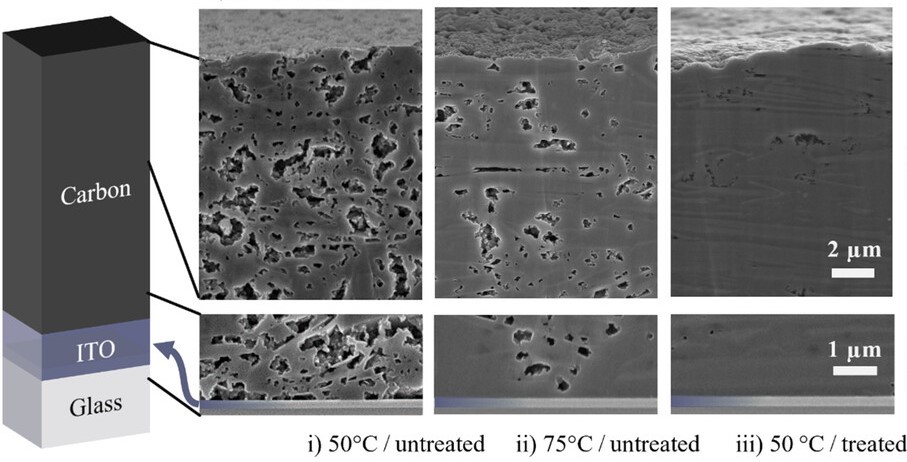Researchers at the Fraunhofer Institute for Solar Energy Systems ISE (Fraunhofer ISE) in Germany have shown that a solvent treatment of laminated carbon top electrodes in triple-cation perovskite solar cells improves performance, bringing carbon electrodes closer to being an alternative to metal electrodes.
“Carbon-based electrodes are very promising for perovskite solar cells as they do not react with mobile ions. For metal electrodes, this reaction is a main issue limiting device stability,” Markus Kohlstaedt, team leader perovskite thin-film photovoltaics research at Fraunhofer ISE, told pv magazine.
“The benefit of a lamination process over directly printing the carbon electrode is that it is a solvent-free process: this makes carbon deposition compatible with a wide range of functional materials, including hole transport layers (HTL),” said Kohlstaedt.
To be successful with the alternative approach, the researchers had to overcome challenges, such as the blade coating’s tendency to damage charge transport layers, typically Spiro-OMeTAD, due to solvent incompatibility, and the tendency of laminated carbon (LMC) electrodes to exhibit increased series resistance.
“We were able to significantly increase the electrical properties of the carbon electrode by a solvent treatment after lamination. This helps to soften the material and achieve a better electrical contact when applying pressure again. Following this process, we observe a nicely compact carbon layer while the original layer featured lots of voids that reduced the conductive properties,” explained Kohlstaedt.
The team’s cell was based on mixed-halide triple-cation perovskite absorber layers, specifically cesium iodide (CsI), methylammonium bromide (MABr) and formamidinium iodide (FAI) lead iodide (PbI2), known as FA0.85MA0.1Cs0.05Pb (I2.9Br0.1).
Four device types were fabricated to test the approach: a blade-coated carbon HTL-free to represent the basic carbon perovskite solar cell baseline; LMC without HTL to reveal the effect of lamination alone; LMC with Spiro-OMeTAD to test compatibility with sensitive charge transport layers; and gold (Au) on Spiro-OMeTAD as a benchmark.
The researchers found that LMC electrodes enabled open-circuit voltages of up to 1.08 V and low hysteresis. That result was further improved by applying a solvent treatment to the LMC, which “significantly” reduced the series resistance by simultaneously reducing sheet and contact resistance.
The results were confirmed by scanning electron microscopy (SEM) analysis, dark lock-in thermography (DLIT) measurements, and simulations. “Among the tested solvents, o-xylene yielded the best performance, with treated LMC devices achieving efficiencies of 18.9% (reverse scan) and 18.7% (forward scan), approaching those of gold-based references,” noted the researchers.
Further performance gains were realised by improving the electron transport layer, enabling LMC-based perovskite solar cells to reach efficiencies up to 20.4%, compared to 21.4% for gold-based counterparts.
The research appears in “Tuning Porosity in Laminated Carbon Electrodes via Solvent Treatment Enables >20% Efficient Perovskite Solar Cells,” in Solar RRL.
“We are now getting close to a situation where we have overcome the drawbacks of carbon electrodes in comparison to metal electrodes, namely lower power conversion efficiencies,” said Kohlstaedt.
“I am very optimistic that this device architecture can now fully unfold their opportunities of being very easily processable by coating/printing processes at ambient conditions and by being the most stable electrode material available for perovskite solar cells.”
This content is protected by copyright and may not be reused. If you want to cooperate with us and would like to reuse some of our content, please contact: editors@pv-magazine.com.



By submitting this form you agree to pv magazine using your data for the purposes of publishing your comment.
Your personal data will only be disclosed or otherwise transmitted to third parties for the purposes of spam filtering or if this is necessary for technical maintenance of the website. Any other transfer to third parties will not take place unless this is justified on the basis of applicable data protection regulations or if pv magazine is legally obliged to do so.
You may revoke this consent at any time with effect for the future, in which case your personal data will be deleted immediately. Otherwise, your data will be deleted if pv magazine has processed your request or the purpose of data storage is fulfilled.
Further information on data privacy can be found in our Data Protection Policy.